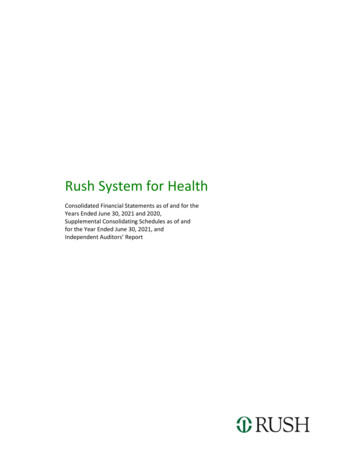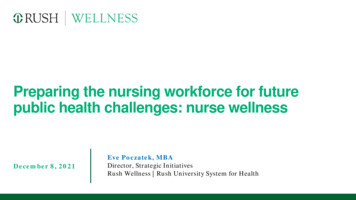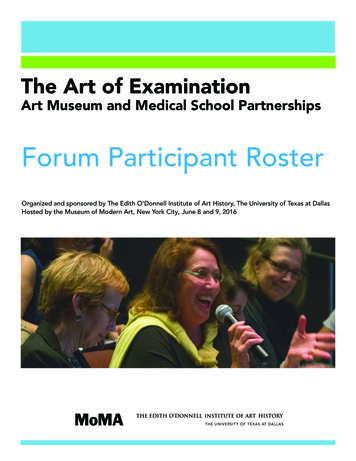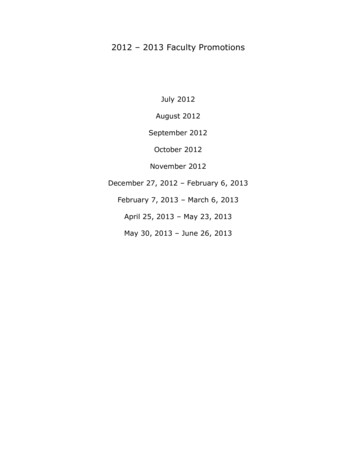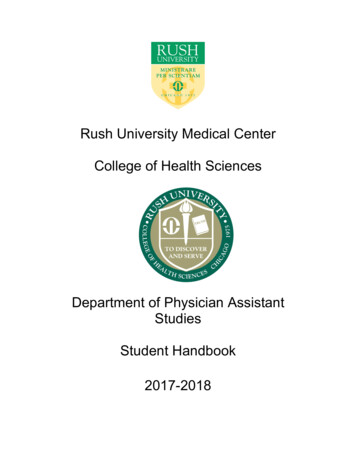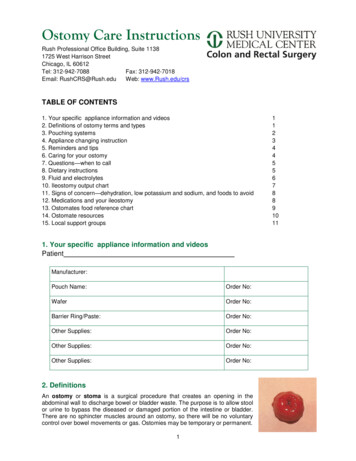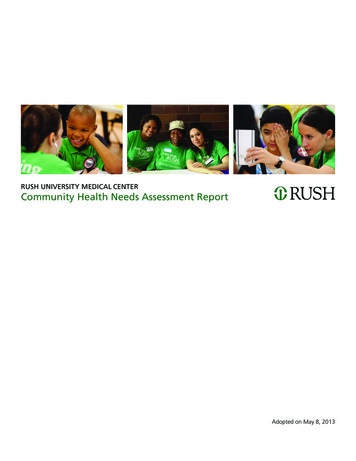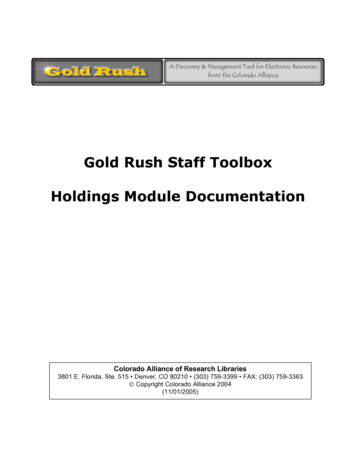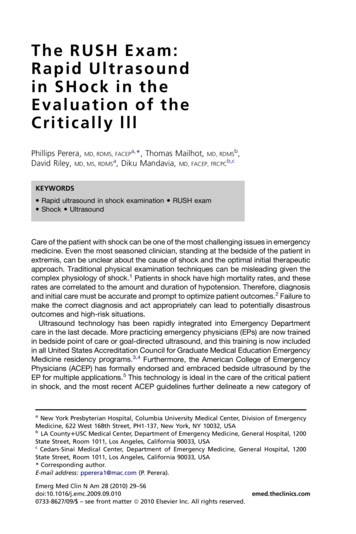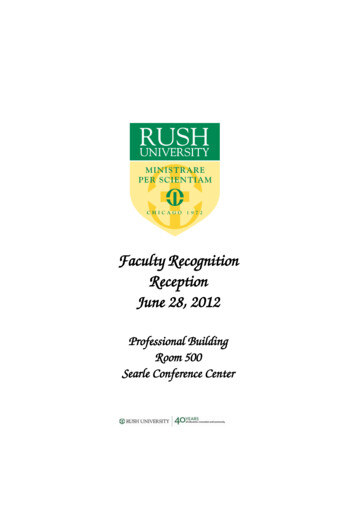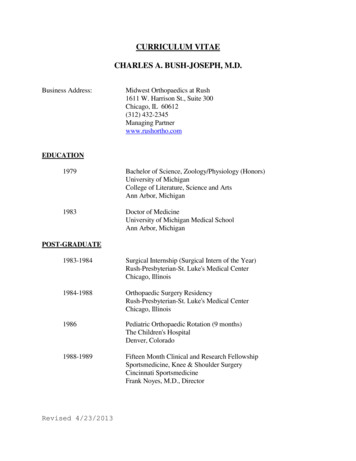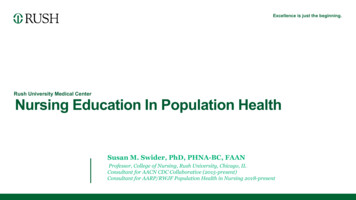
Transcription
Excellence is just the beginning.Rush University Medical CenterNursing Education In Population HealthSusan M. Swider, PhD, PHNA-BC, FAANProfessor, College of Nursing, Rush University, Chicago, ILConsultant for AACN CDC Collaborative (2015-present)Consultant for AARP/RWJF Population Health in Nursing 2018-present
HEALTH CARE CHALLENGES IN THE USRush University 6/7/20192
Title of presentation3Rush University 6/7/20193
POPULATION HEALTH» Population Health: the health outcomes of a group of individuals includingthe distribution of such outcomes within the group (Kindig and Stoddart,2003). Addresses health equity by addressing:– Social and environmental determinants of health– Disease prevention– Care coordination– Population managementRush University 6/7/20194
NURSING AND POPULATION HEALTH» National Advisory Council on Nurse Education and Practice (NACNEP)– Public Health Nursing: Key to Our Nation’s Health lthnursing.pdf– Preparing Nurses for New Roles in Population Health Management advisory/nacnep/Reports/fourteenthreport.pdf» American Association of Colleges of Nursing (AACN) Essentials for NursingEducation: BSN, MSN and DNP N-Essentials» Healthy People Curriculum Task https://www.aptrweb.org/page/HPC TaskforceRush University 6/7/20195
Nursing Education and the Social Determinants of Health National Academy of Sciences /IOM (2016). A Framework forEducating Health Professionals to Address the SocialDeterminants of Health. https://www.nap.edu/read/21923/chapter/1 National League for Nursing (NLN) (2019). A Vision forIntegration of the Social Determinants of Health into NursingEducation Curricula. rsn 26Rush University 6/7/20196
AACN CDC COLLABORATIVE» Five year initiative 2012-2017; renewed 2017-2022– CDC’s Collaboration with Academia to Strengthen Public Health Workforce Capacity– Academic Partnerships to Improve Health (APIH)– Association of American Medical Colleges (AAMC)– Association of Schools and Programs of Public Health (ASPPH)– Association for Prevention Teaching and Research (APTR)» Primary goals:– Strengthen the public health nursing workforce– Enhance the public/population health curriculum in nursing education – BSN, Master’sand DNP– Connect nursing students with hands-on experiences at the community level to enhancetheir preparation for practiceRush University 6/7/20197
AACN CDC COLLABORATIVE» Faculty development ing» DNP Evidence-Based Population Health ojects» Small Evaluation Grants Program ng/Small-Evaluation-Grants-Program» Population Health Learning Hubs ng/Public-Health-Learning-Hubs» Collaboration to enhance curriculum– The Practical Playbook https://www.practicalplaybook.org/– Camden Coalition https://hotspotting.camdenhealth.org/Rush University 6/7/20198
AACN CDC COLLABORATIVEMeasuring Population Health Competencies» Developing methods to measure population health competencies– Quad Council Competencies for Public Health 018-qcc-competencies/» Pilot test vignette to assess student skills in applying core content––––Social Determinants of Health (SDOH)Program Planning & Evaluation; Data AnalysisCommunicating to Multiple Audiences/GroupsCreating Healthy Communities; Social Ecological Model of Health» Pilot test Results:– 275 of 707 BSN Nursing programs; 3400 students– the tool was valid and reliable; progression through curriculum was strongest predictor ofsuccess (p .01).Rush University 6/7/20199
POPULATION HEALTH IN NURSING-1 (PHIN-1)» Purpose: describe promising educational models to prepare nurses, across alllevels of professional practice, for population health practice and leadership.– SurveyIn depth interviews– Nursing; medicine; public health– Site visits––––––Rush UniversityOregon Health Sciences UniversityUniversity of North Carolina Chapel HillRutgers UniversityThomas Jefferson UniversityUniversity of Washington Tacoma campusRush University 6/7/201910
PHIN 1 FINDINGSCore Content and Competencies» Policy impact on health outcomes» Epidemiology/biostatistics.» Assess and Address the social determinants of health and illness across populations andsettings» Health equity as an overall goal of health care.» Interprofessional team-building» Health care economics, including basic payment models and impact on servicesdelivered/outcomes achieved.» Systems thinking, including understanding complex demands, developing solutions andmanage change.Rush University 6/7/201911
PHIN 1 FINDINGSTeaching Methods» Case studies and simulation» Intentional and structured academic-practice partnerships» Interprofessional education (IPE) experiences» Service learningBenefits» Faculty practice and student clinical models have potential to benefit both students and thepopulation.Challenges» Little experience in measuring student learning outcomes.» Little work on measuring the impact of student and faculty efforts on population health outcomes.» Lack of faculty prepared in population healthRush University 6/7/201912
PHIN 1 RECOMMENDATIONS»»»»Disseminate/discuss findings with professional nursing education organizationsExplore measures of population health competency across all levels of nursing educationContinue to explore successful IPE models as they relate to population healthUse PHIN 1 lessons learned to inform PHIN 2 goals and methods.– PHIN 2: to identify and define key components of successful academic practice partnerships/interdisciplinary models with the potential to prepare nurses for practice, education, andleadership in population health. Emphasis will be placed on models with potential to:– Demonstrate outcomes and scalability– Influence competencies and curriculum– Align with interprofessional education– Align with employment incentives– Unify social determinants of health concepts in practiceRush University 6/7/201913
RECOMMENDATIONS/FUTURE DIRECTIONS» AACN Essentials Revision (in process)» Competency measures and tools» Faculty development» Develop/test models with nurses as key components of population healthimprovement» Document nursing value added to population health improvement models» Continuing Education for current nursesRush University 6/7/201914
Thank you.
Professor, College of Nursing, Rush University, Chicago, IL. Consultant for AACN CDC Collaborative (2015-present) Consultant for AARP/RWJF Population Health in Nursing 2018-present. Rush University 6/7/2019 2 . - Association of American Medical Colleges (AAMC)
